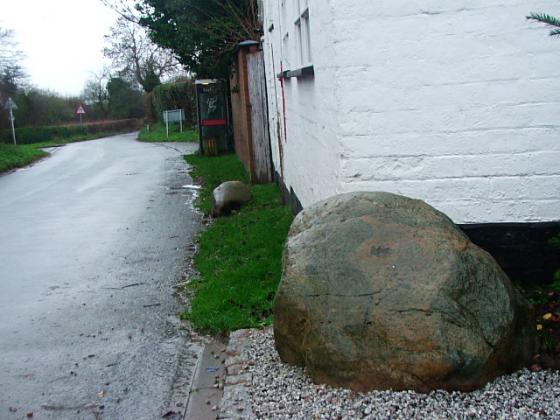I can’t find mention of this stone anywhere else. And it might not exist any more. But it might, and so I can’t resist adding it as it has such typically stoney folklore, plus it’s got a cow’s footmark, allegedly.
In the village of Little Oun, about eight miles from Stafford, there is a large house, now used as a farm-house, but once inhabited by an old and highly respectable family named C. Close to the side of the road leading to the house, from which it is distant about a hundred yards, lies a large boulder, most likely from Shap Fells, or some other of the Cumberland or Westmoreland hills. It is very large, weighing several tons, and upon the exposed surface of it is an impression not unlike that of a cow’s hoof. Before the following event, the stone was two or three yards above the surface, but now it is not much more than one.
The superstition attached to this stone, – which was and, I may say, still is religiously believed in by the country people for miles around, – was that the fortunes of the C. family were indissolubly linked with the fate of the stone: – that as this latter remained high and elevated as it then was, so would the family be prosperous, and that as the stone subsided, so likewise would the dignity and wealth of the C.s sink. Now it happened, one day, that an ancestor of Lord Bradford was riding to dine at the Hall, when his horse took fright at this large stone and threw his rider, who, I believe, was killed on the spot. The owner of the Hall, to prevent the recurrence of a like accident, caused sixteen horses to be yoked together so as to remove the boulder from the side of the road. However, the stone refused to stir an inch. For this impious attempt, tradition relates that, the poor horses suffered; for the story goes that all the sixteen died of the distemper within a fortnight. A working man was then employed to dig away the soil from around and beneath it, so as to sink it in that manner. The stone was thus lowered about a yard or so; but the man himself is said never to have done a day’s work afterwards; and to have died very shortly. Immediately after that was done, it is said that great reverses happened to the family, and they lost much of their property.
Now there was a dun cow in the fields about the Hall, quite wild, and looked upon as common property by the villagers. She was most famous for her milking qualities; and it was said that [she] let the people bring whatever number of pails they chose, she never sent any away empty. Truly, a most wonderful dun cow! An old witch, however, who lived in the neighbourhood, determined to see if the milk was really unlimited in quantity. She therefore took a riddle or sieve, and milked the poor cow into this; which, as it never filled, in time milked her dry. Hereupon she went mad immediately, and ran away in the direction of the stone, on which she trod, sinking it deeper in the earth, and leaving her mark upon it. This seemed to be the climax, for very shortly after this event, the family were obliged to leave the neighbourhood. I cannot learn what became of the witch after this mischievous action.
W. A. L.
This from Lancastrensis, in The Athenaeum 992 (Oct 31, 1846): 1116-1117.
Little Onn Hall was only built 1870s (by the Crockett family) but there must have been a house there before – or maybe it was one of the other buildings here. Which makes the site of the stone a bit difficult to work out.

